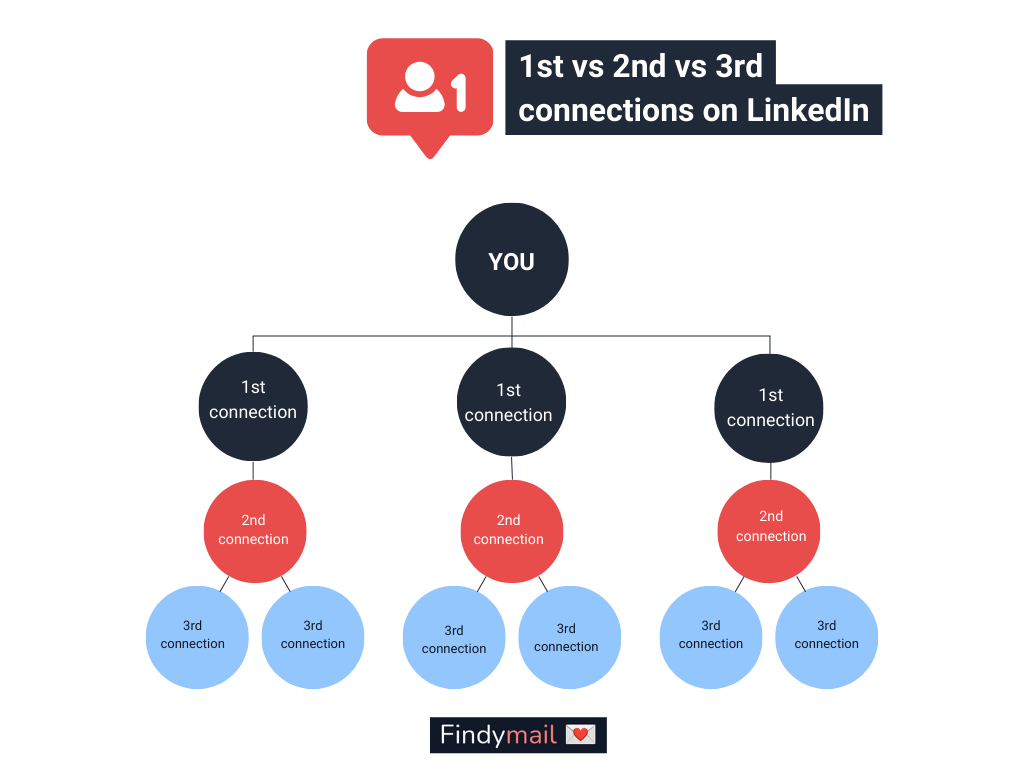1st, 2nd, 3rd: Curious about the meaning of these numbers on LinkedIn profiles?
What Does 1st, 2nd, 3rd Mean on LinkedIn?
The 1st, 2nd, or 3rd symbols can be seen next to a person's name when viewing their LinkedIn page. This shows how close you are connected to this individual.
1. First Degree (1st Degree) Connection Meaning on Linkedin
People you are immediately related to because they accepted your invitation request or you accepted their connection request are known as first-degree connections. You can message them directly through LinkedIn.

Important: When someone is your first-degree connection on LinkedIn, you also have access to their contact information, including their emails and phone numbers.

Simply click "contact info" to get these contact data, and a window will open.
The data available will depend on what that person has filled in their profile and what they decided to share.
Available data include:
- Email (personal or professional): usually it's the email they signed up on Linkedin with
- Birth date
- Phone number
- Connection date
That data is almost always exclusive to 1st-degree connections but some people share it to 2nd and 3rd connections as well.
2. Second Degree (2nd Degree) Connection Meaning on Linkedin
On LinkedIn, having a second-degree relationship means that while you are not directly connected to the individual but someone in your network is.
Your connections with them are shown when you see their profile, directly above the "Connect" button.
They must first accept a connection request before you can send them a direct message.
You can send an inmail to omit the connection request phase.
You can direct message second and third-degree connections on Linkedin using inmails, even if you are not yet connected to them. For that you need to buy a premium subscription to Linkedin, either Linkedin Premium or Linkedin Sales Navigator.
You can also click "Contact Info," but more often than not that won't give you access to their contact information.
3. Third Degree (3rd Degree) Connection Meaning on Linkedin
People with whom you are related at the third degree are known as third-degree connections. They are associates of your acquaintances. Sending a connection request to them will allow you to connect with them, but the button is not in the same location.
Third-degree LinkedIn connections can also use inmails.
It is evident that only premium members of LinkedIn have access to this option.
Good to know: If you are a member of the same LinkedIn group or event, you can still send direct messages to 2nd and 3rd-degree connections even if you are not a premium LinkedIn user.
4. Third Degree Plus (+3rd+ Degree) Connection Meaning on Linkedin
People with whom you have a third-degree connection are not first-degree or second-degree connections. You are separated from these people by more than two people.
You now fully understand the meanings of the first three linkedin terms.
Let's look at how to utilize this knowledge to connect with anyone on LinkedIn.
What to know about Linkedin connections
Now that you understand better the meaning of those "1st 2nd 3rd" stuff, you can go the extra mile and understand how the whole connection game on Linkedin works.

How Can I Maximize my Chance of Connecting with Someone?
When sending a connection request, you want it to be accepted. But how to maximize your chance?
I get a lot of connection requests every day and the truth is: it will depend on what the recipient is seeking from Linkedin. The hard truth is some people will more easily accept requests than others. That said, it's not very actionable. There are still things you can do to improve your acceptance rate.
The first thing I recommend is to not send a note if it's not personalized. You read that right. If you're not crafting a personal message for that person, your best bet is to not add a note at all.
Generic messages perform a lot worse because it shows low effort and looks like spam. It also makes you look like a fool.
How to Bypass Linkedin Weekly Invite Limitation on Connection Requests?
You are now only permitted to send a certain number of connection requests on LinkedIn.
There is currently a weekly cap of ~100 connection requests.
Workarounds used to exist such as using the email invite feature to send more invitations but this got disabled recently. Stay on the lookout for updates on this limit as it's frequently changing!
How To Cancel Connection Requests on Linkedin?
There is a chance that LinkedIn may start to suspect you are a spammer if you consistently send out a lot of connection requests but only a small number are accepted.
There are two remedies for this:
- Select the appropriate audience and make proper connection requests (so a maximum get accepted)
- Delete any connection requests that are more than 3 to 4 weeks old.
Go to My Network > Manage to remove an old connection request.
Then click on Sent > Withdraw
If I decline an invitation from LinkedIn, who will find out?
Nobody. Users on LinkedIn are not informed if you reject a connection request. However, they might observe that the connection request is no longer listed.
Do requests for connections on LinkedIn expire?
Yes. After six months, they will automatically expire.






